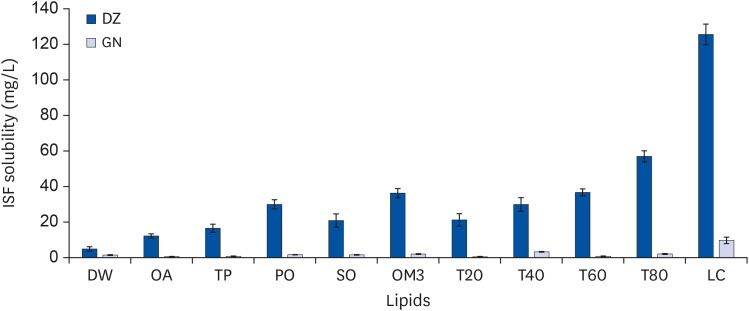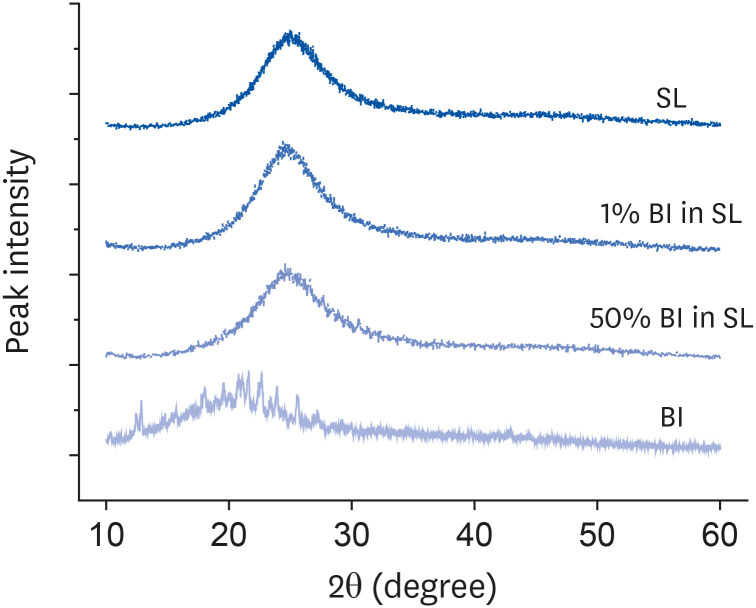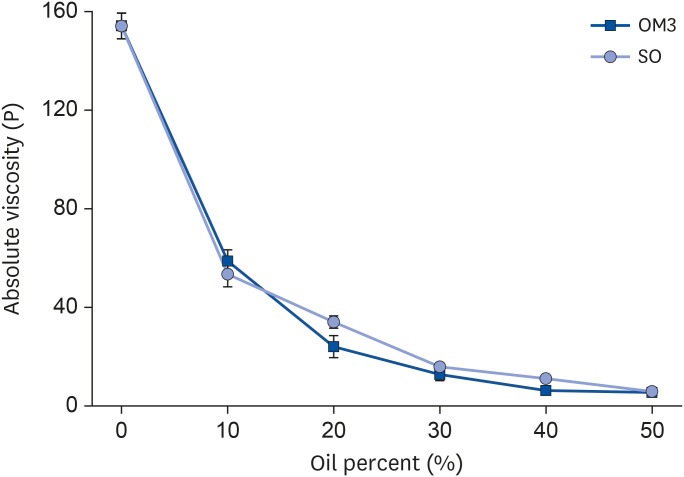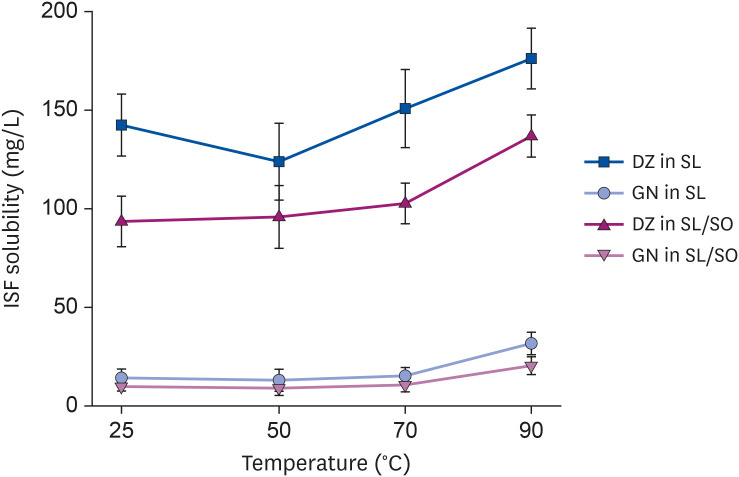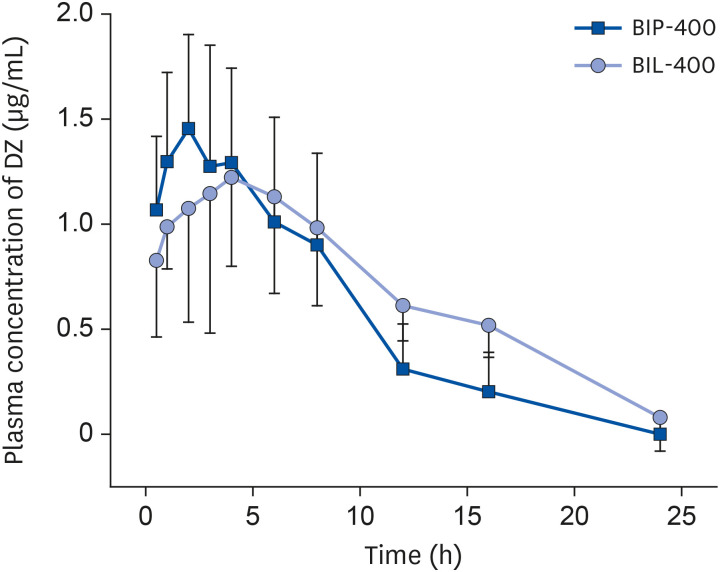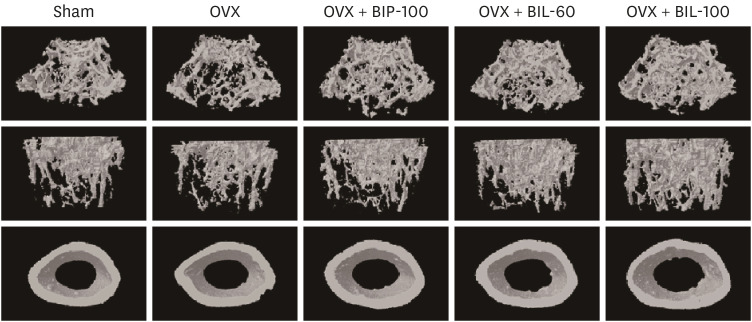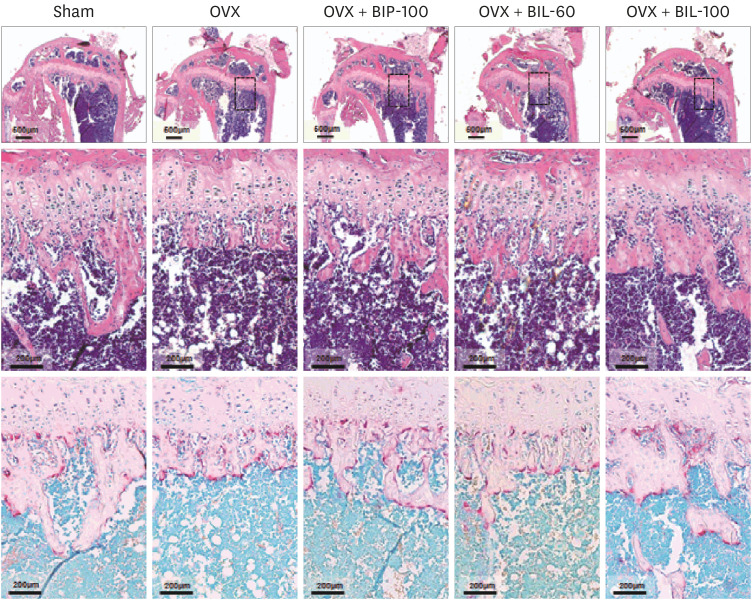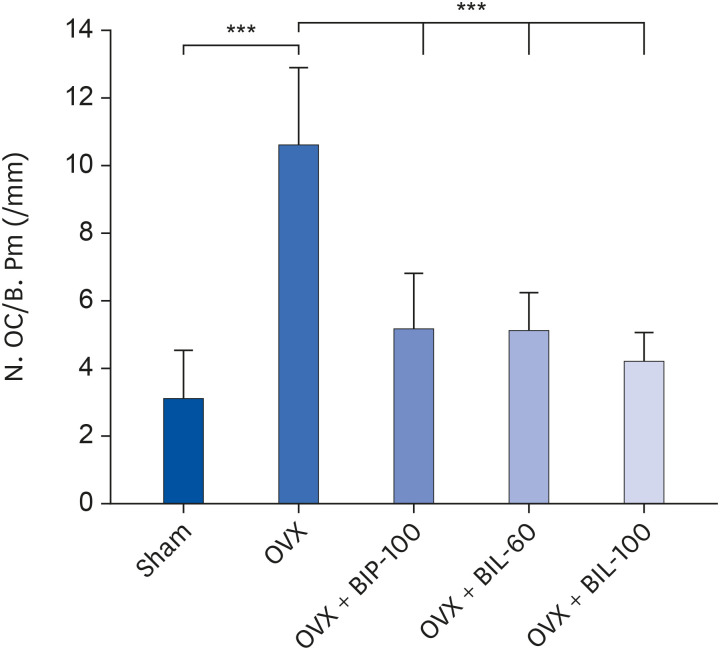Nutr Res Pract.
2021 Oct;15(5):541-554. 10.4162/nrp.2021.15.5.541.
Combined effects of soy isoflavone and lecithin on bone loss in ovariectomized mice
- Affiliations
-
- 1Osteon Co. Ltd, Daejeon 34013, Korea
- 2Department of Pathology and Regenerative Medicine, School of Dentistry, Kyungpook National University, Daegu 41940, Korea
- KMID: 2520657
- DOI: http://doi.org/10.4162/nrp.2021.15.5.541
Abstract
- BACKGROUND/OBJECTIVES
Isoflavones (ISFs) are effective in preventing bone loss, but not effective enough to prevent osteoporosis. Mixtures of soy ISF and lecithin (LCT) were prepared and characterized in an attempt to improve the bone loss.
MATERIALS/METHODS
The daidzein (DZ) and genistein (GN) solubility in soy ISF were measured using liquid chromatography-mass spectrometry. The change in the crystalline characteristics of soy ISF in LCT was evaluated using X-ray diffraction analysis. Pharmacokinetic studies were conducted to evaluate and compare ISF bioavailability. Animal studies with ovariectomized (OVX) mice were carried out to estimate the effects on bone loss. The Student's t-test was used to evaluate statistical significance.
RESULTS
The solubility of DZ and GN in LCT was 125.6 and 9.7 mg/L, respectively, which were approximately 25 and 7 times higher, respectively, than those in water. The bioavailability determined by the area under the curve of DZ for the oral administration (400 mg/kg) of soy ISF alone and the soy ISF-LCT mixture was 13.19 and 16.09 µg·h/mL, respectively. The bone mineral density of OVX mice given soy ISF-LCT mixtures at ISF doses of 60 and 100 mg/kg daily was 0.189 ± 0.020 and 0.194 ± 0.010 g/mm3 , respectively, whereas that of mice given 100 mg/kg soy ISF was 0.172 ± 0.028 g/mm3 . The number of osteoclasts per bone perimeter was reduced by the simultaneous administration of soy ISF and LCT.
CONCLUSIONS
The effect of preventing bone loss and osteoclast formation by ingesting soy ISF and LCT at the same time was superior to soy ISF alone as the bioavailability of ISF may have been improved by the emulsification and solvation of LCT. These results suggest the possibility of using the combination of soy ISF and LCT to prevent osteoporosis.
Keyword
Figure
Reference
-
1. Akkawi I, Zmerly H. Osteoporosis: current concepts. Joints. 2018; 6:122–127. PMID: 30051110.
Article2. Pisani P, Renna MD, Conversano F, Casciaro E, Di Paola M, Quarta E, Muratore M, Casciaro S. Major osteoporotic fragility fractures: risk factor updates and societal impact. World J Orthop. 2016; 7:171–181. PMID: 27004165.
Article3. Sattui SE, Saag KG. Fracture mortality: associations with epidemiology and osteoporosis treatment. Nat Rev Endocrinol. 2014; 10:592–602. PMID: 25091729.
Article4. Ahlborg HG, Johnell O, Turner CH, Rannevik G, Karlsson MK. Bone loss and bone size after menopause. N Engl J Med. 2003; 349:327–334. PMID: 12878739.
Article5. Väänänen HK, Härkönen PL. Estrogen and bone metabolism. Maturitas. 1996; 23(Suppl):S65–S69. PMID: 8865143.
Article6. Hedlund LR, Gallagher JC. The effect of age and menopause on bone mineral density of the proximal femur. J Bone Miner Res. 1989; 4:639–642. PMID: 2816509.
Article7. Chen X, Anderson JJB. Isoflavones and bone: animal and human evidence of efficacy. J Musculoskelet Neuronal Interact. 2002; 2:352–359. PMID: 15758427.8. Picherit C, Chanteranne B, Bennetau-Pelissero C, Davicco MJ, Lebecque P, Barlet JP, Coxam V. Dose-dependent bone-sparing effects of dietary isoflavones in the ovariectomised rat. Br J Nutr. 2001; 85:307–316. PMID: 11299076.
Article9. Kim MS, Lee YS. Effects of soy isoflavone and/or estrogen treatments on bone metabolism in ovariectomized rats. J Med Food. 2005; 8:439–445. PMID: 16379553.
Article10. Kim DW, Yoo KY, Lee YB, Lee KH, Sohn HS, Lee SJ, Cho KH, Shin YK, Hwang IK, Won MH, Kim DW. Soy isoflavones mitigate long-term femoral and lumbar vertebral bone loss in middle-aged ovariectomized mice. J Med Food. 2009; 12:536–541. PMID: 19627201.
Article11. Zheng X, Lee SK, Chun OK. Soy isoflavones and osteoporotic bone loss: a review with an emphasis on modulation of bone remodeling. J Med Food. 2016; 19:1–14. PMID: 26670451.
Article12. Ma DF, Qin LQ, Wang PY, Katoh R. Soy isoflavone intake inhibits bone resorption and stimulates bone formation in menopausal women: meta-analysis of randomized controlled trials. Eur J Clin Nutr. 2008; 62:155–161. PMID: 17392695.
Article13. Xiao Y, Zhang S, Tong H, Shi S. Comprehensive evaluation of the role of soy and isoflavone supplementation in humans and animals over the past two decades. Phytother Res. 2018; 32:384–394. PMID: 29193539.
Article14. Mei J, Yeung SS, Kung AW. High dietary phytoestrogen intake is associated with higher bone mineral density in postmenopausal but not premenopausal women. J Clin Endocrinol Metab. 2001; 86:5217–5221. PMID: 11701680.
Article15. Ma DF, Qin LQ, Wang PY, Katoh R. Soy isoflavone intake increases bone mineral density in the spine of menopausal women: meta-analysis of randomized controlled trials. Clin Nutr. 2008; 27:57–64. PMID: 18063230.
Article16. Taku K, Melby MK, Takebayashi J, Mizuno S, Ishimi Y, Omori T, Watanabe S. Effect of soy isoflavone extract supplements on bone mineral density in menopausal women: meta-analysis of randomized controlled trials. Asia Pac J Clin Nutr. 2010; 19:33–42. PMID: 20199985.17. Lee H, Choue R, Lim H. Effect of soy isoflavones supplement on climacteric symptoms, bone biomarkers, and quality of life in Korean postmenopausal women: a randomized clinical trial. Nutr Res Pract. 2017; 11:223–231. PMID: 28584579.
Article18. Kenny AM, Mangano KM, Abourizk RH, Bruno RS, Anamani DE, Kleppinger A, Walsh SJ, Prestwood KM, Kerstetter JE. Soy proteins and isoflavones affect bone mineral density in older women: a randomized controlled trial. Am J Clin Nutr. 2009; 90:234–242. PMID: 19474141.
Article19. Brink E, Coxam V, Robins S, Wahala K, Cassidy A, Branca F. PHYTOS Investigators. Long-term consumption of isoflavone-enriched foods does not affect bone mineral density, bone metabolism, or hormonal status in early postmenopausal women: a randomized, double-blind, placebo controlled study. Am J Clin Nutr. 2008; 87:761–770. PMID: 18326616.
Article20. Kwak HS, Park SY, Kim MG, Yim CH, Yoon HK, Han KO. Marked individual variation in isoflavone metabolism after a soy challenge can modulate the skeletal effect of isoflavones in premenopausal women. J Korean Med Sci. 2009; 24:867–873. PMID: 19794985.
Article21. Ward WE, Fonseca D. Soy isoflavones and fatty acids: effects on bone tissue postovariectomy in mice. Mol Nutr Food Res. 2007; 51:824–831. PMID: 17604386.
Article22. Watkins BA, Reinwald S, Li Y, Seifert MF. Protective actions of soy isoflavones and n-3 PUFAs on bone mass in ovariectomized rats. J Nutr Biochem. 2005; 16:479–488. PMID: 16043030.
Article23. Simopoulos AP. Omega-3 fatty acids in inflammation and autoimmune diseases. J Am Coll Nutr. 2002; 21:495–505. PMID: 12480795.
Article24. Watkins BA, Li Y, Lippman HE, Seifert MF. Omega-3 polyunsaturated fatty acids and skeletal health. Exp Biol Med (Maywood). 2001; 226:485–497. PMID: 11395919.25. Ciriminnaa R, Meneguzzob F, Delisia R, Pagliaro M. Enhancing and improving the extraction of omega-3 from fish oil. Sustain Chem Pharm. 2017; 5:54–59.26. Goicoechea E, Brandon EFA, Blokland MH, Guillén MD. Fate in digestion in vitro of several food components, including some toxic compounds coming from omega-3 and omega-6 lipids. Food Chem Toxicol. 2011; 49:115–124. PMID: 20937346.27. Ismail A, Bannenberg G, Rice HB, Schutt E, MacKay D. Oxidation in EPA- and DHA-rich oils: an overview. Lipid Technol. 2016; 28:55–59.
Article28. Fricker G, Kromp T, Wendel A, Blume A, Zirkel J, Rebmann H, Setzer C, Quinkert RO, Martin F, Müller-Goymann C. Phospholipids and lipid-based formulations in oral drug delivery. Pharm Res. 2010; 27:1469–1486. PMID: 20411409.
Article29. Uchida R, Chiba H, Ishimi Y, Uehara M, Suzuki K, Kim H, Matsumoto A. Combined effects of soy isoflavone and fish oil on ovariectomy-induced bone loss in mice. J Bone Miner Metab. 2011; 29:404–413. PMID: 21069546.
Article30. Ihn HJ, Kim JA, Lim S, Nam SH, Hwang SH, Lim J, Kim GY, Choi YH, Jeon YJ, Lee BJ, Bae JS, Kim YH, Park EK. Fermented oyster extract prevents ovariectomy-induced bone loss and suppresses osteoclastogenesis. Nutrients. 2019; 11:1392–1403.
Article31. Jia L, Xu S, Liu S, Du S, Wu S, Gong J. Polymorphs of daidzein and intermolecular interaction effect on solution crystallization. CrystEngComm. 2017; 19:7146–7153.
Article32. Zhang Z, Huang Y, Gao F, Bu H, Gu W, Li Y. Daidzein-phospholipid complex loaded lipid nanocarriers improved oral absorption: in vitro characteristics and in vivo behavior in rats. Nanoscale. 2011; 3:1780–1787. PMID: 21350765.33. Lee SH, Kim YH, Yu HJ, Cho NS, Kim TH, Kim DC, Chung CB, Hwang YI, Kim KH. Enhanced bioavailability of soy isoflavones by complexation with β-cyclodextrin in rats. Biosci Biotechnol Biochem. 2007; 71:2927–2933. PMID: 18071265.
Article34. Deshpande AA, Rhodes CT, Shah NH, Malick AW. Controlled-release drug delivery systems for prolonged gastric residence: an overview. Drug Dev Ind Pharm. 1996; 22:531–539.
Article
- Full Text Links
- Actions
-
Cited
- CITED
-
- Close
- Share
- Similar articles
-
- Calcium and Phosphorus Balance Study by Soy Isoflavone Intake in Ovariectomized Rats
- The Effect of Isoflavone and/or Grape Seed Oil Supplementation on Blood Lipid Profiles and Bone Strength in Ovariectomized Female Rats
- Effects of Soy Isoflavone Supplementation and Exercise on Bone Mineral Density and Urinary Deoxypyridinoline in Postmenopausal Women
- Validation of soy isoflavone intake and its health effects: a review of the development of exposure biomarkers
- Effect of isoflavone-enriched whole soy milk powder supplementation on bone metabolism in ovariectomized mice

